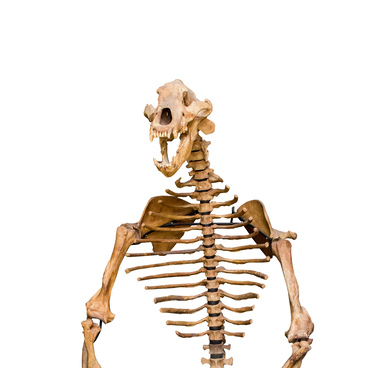The Pareiasaur is a representative of large herbivore (plant-eating) creatures that lived in Africa, South America, Europe, and modern China in the Permian period.
The word Pareiasaur means a cheek lizard. These animals were so called because of the wide bones on either side of the skull, which gave the head a triangular shape and created the illusion of truly large cheeks.
Pareiasaurs lived on Earth about 250-265 million years ago. Towards the end of the Permian period, they were at their heyday, as the climate became drier, the seas gradually shrank in size, and wide rivers flowed across the plains. Pareiasaurs settled near large reservoirs and lived in herds, almost like modern hippopotamuses. Their teeth were weak; they could only grind soft food. It is probable that the basis of their diet was seaweed. These animals ranged in size from one and a half to four meters long. They had strong limbs, a massive lumpy skull, and a barrel-shaped body. Adults could weigh up to 700-900 kilograms. Bony scutes were set into the skin of their back and head, which made the skin look lumpy and uneven.
Pareiasaurs probably were hunted by the large predators of the time: Gorgonopsia, Dinogorgon, Rubidgea. The herbivores had no means of defending themselves, and their short, massive paws made it impossible to run away quickly. However, some scientists suggest that Pareiasaurs could strike opponents with their wide and strong cheekbones.
The first fossils of Pareiasaurs were discovered on the banks of the Vyatka River, near the town of Kotelnich, at the beginning of the 20th century. Prior, it was believed that such animals lived only in South Africa. However, Soviet scientists did not begin any large-scale excavations and detailed studies of this species until the 1980s. They found that the Vyatka Pareiasaurs did not differ in their structure or lifestyle from their South African relatives.
For some time these reptiles were believed to be the ancestors of turtles. However, paleontologists state it is not true. They believe, Pareiasaurs became extinct, and there are no descendants of them among modern animals.
The word Pareiasaur means a cheek lizard. These animals were so called because of the wide bones on either side of the skull, which gave the head a triangular shape and created the illusion of truly large cheeks.
Pareiasaurs lived on Earth about 250-265 million years ago. Towards the end of the Permian period, they were at their heyday, as the climate became drier, the seas gradually shrank in size, and wide rivers flowed across the plains. Pareiasaurs settled near large reservoirs and lived in herds, almost like modern hippopotamuses. Their teeth were weak; they could only grind soft food. It is probable that the basis of their diet was seaweed. These animals ranged in size from one and a half to four meters long. They had strong limbs, a massive lumpy skull, and a barrel-shaped body. Adults could weigh up to 700-900 kilograms. Bony scutes were set into the skin of their back and head, which made the skin look lumpy and uneven.
Pareiasaurs probably were hunted by the large predators of the time: Gorgonopsia, Dinogorgon, Rubidgea. The herbivores had no means of defending themselves, and their short, massive paws made it impossible to run away quickly. However, some scientists suggest that Pareiasaurs could strike opponents with their wide and strong cheekbones.
The first fossils of Pareiasaurs were discovered on the banks of the Vyatka River, near the town of Kotelnich, at the beginning of the 20th century. Prior, it was believed that such animals lived only in South Africa. However, Soviet scientists did not begin any large-scale excavations and detailed studies of this species until the 1980s. They found that the Vyatka Pareiasaurs did not differ in their structure or lifestyle from their South African relatives.
For some time these reptiles were believed to be the ancestors of turtles. However, paleontologists state it is not true. They believe, Pareiasaurs became extinct, and there are no descendants of them among modern animals.



